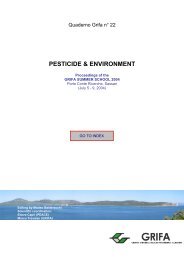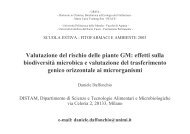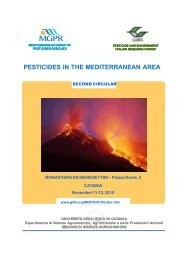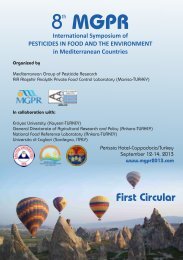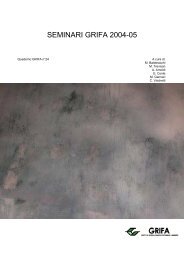International Congress BIOLOGICAL PRODUCTS - Gruppo di ...
International Congress BIOLOGICAL PRODUCTS - Gruppo di ...
International Congress BIOLOGICAL PRODUCTS - Gruppo di ...
Create successful ePaper yourself
Turn your PDF publications into a flip-book with our unique Google optimized e-Paper software.
19<br />
DETERMINATION OF PHENOLIC COMPOUNDS IN EXPERIMENTAL WINES SUBJECTED TO<br />
DIFFERENT PESTICIDES TREATMENTS<br />
G. L .La Torre, T. M. Pellicanò, D.Pollicino, M. Alfa, G.mo Dugo<br />
Università degli Stu<strong>di</strong> <strong>di</strong> Messina; Dip.to <strong>di</strong> Chimica Organica e Biolog ica<br />
INTRODUCTION<br />
Wine is a complex fluid; it contains water, sugars, acids, alcohols and a wide range of phenolic compounds. The<br />
phenolics can be derived from grapes and wood, or they can be metabolites from yeasts. Phenolics occur<br />
naturally in various families of plants, but grapes and related products are considered one of the most important<br />
<strong>di</strong>etary sources of these substances (1, 2). Phenolic compounds are an important group of substances that<br />
contribute to several sensorial characteristics such as colour, flavour, astringency and hardness of wine.<br />
Furthermore, these compounds are important in food hygiene because of their bactericidal effects and,<br />
consequently, they constitute an interesting index for evaluating the quality of a wine (3 - 5). Some researchers<br />
suggest that a regular consumption of a moderate quantity of wine, especially red (6-8), is therapeutic for human<br />
health. This protective effect has been associated with an increase in the plasma of the level of high-density<br />
lipoprotein (HDL)-cholesterol and with a decrease of platelet activity, because of the effect of ethanol and<br />
polyphenolic components (9). Epidemiological stu<strong>di</strong>es have shown that a moderate wine consumption helps to<br />
prevent the development of coronary heart <strong>di</strong>sease (10,11).<br />
The major molecules responsibles for this physiologic protection are phenolic compounds such as resveratrol<br />
and flavonoids. Moreover, it has been reported that resveratrol, quercetin and other polyphenolics are cancer<br />
chemo-preventive agents, since through the inhibition of cyclooxygenase they restrain cellular events associated<br />
with tumour initiation, promotion and progression, and stimulate quinone reductase – an enzyme that detoxifies<br />
carcinogens (12,13). In recent years, interest has been focused on resveratrol (3,5,4’-trihydroxystilbene), a<br />
phytoalexin produced by the plant as a defence response to some exogenous stimuli, such as ultraviolet ra<strong>di</strong>ation,<br />
chemical stressor and, particularly, microbial infections (15). It is well-known that resveratrol is present in the<br />
chemical form of cis- and trans-resveratrol and of cis- and trans-piceid ( β-glucosides of resveratrol) (16). The<br />
presence of resveratrol has been detected in numerous types of wines, originating from various countries (USA,<br />
France, Italy, Spain, Japan), and large variations in its content are reported. They depend on grape cultivar,<br />
geographic origin, wine type, Botrytis infection and enological practices. Generally, many authors found that<br />
higher contents of trans-resveratrol (0.2 - 13 mg/L) are usually present in red wines that have had a prolonged<br />
contact between the must and skins, whereas lower concentrations (0.1 - 0.8 mg/L) are usually present in white<br />
wine (17, 18). In rosé wines the levels of resveratrol monomers were between white and red wines (18). About<br />
β-glucosides of resveratrol, no proportionality between the levels of cis- and trans-resveratrol and their<br />
glucosides were reported (19), whereas piceid concentrations from 0.3 mg/L to 9 mg/L in red wines and from 0.1<br />
mg/L to 2.2 mg/L in white wines have been detected (14). Stu<strong>di</strong>es on resveratrol content in wines are numerous<br />
(20-24); they are often focussed on the <strong>di</strong>fferent grape cultivars and associated with the identification of<br />
polyphenolic compounds, of potential biological activities, such as quercetin, myricetin, etc. The phenolic<br />
compounds are secondary plant metabolites that are contained within the skin, seed, and flesh of grapes and are<br />
extracted into wines (especially red) during the process of vinification. The types and concentrations of the<br />
phenolic compounds in wine may depend on a number of factors: grape variety and ripening stage, soil and<br />
climatic con<strong>di</strong>tions. Moreover, the processes of viticulture and vinification, which vary between countries,<br />
regions and wine-makers, determine the content and profile of phenolic compounds in wine (14). The<br />
concentration of phenolic compounds is marked by temperature, so places with high temperatures and drier<br />
con<strong>di</strong>tions <strong>di</strong>sfavour the presence of these compounds in wines.(16)<br />
The purpose of this study was to determine the polyphenolic compounds (resveratrol, piceid, and flavonoids) in<br />
wines from three <strong>di</strong>fferent Italian regions, obtained from grapes (Sangiovese, Fiano d’Avellino, Inzolia-<br />
Caricante (50/50)) treated with <strong>di</strong>fferent pesticides and to investigate the probable influence of the <strong>di</strong>fferent<br />
treatments on the quality of the wines.<br />
MATERIALS AND METHODS<br />
Chemicals and materials<br />
trans-Resveratrol was purchased from Sigma Chemical Co. Stock solution of cis-resveratrol was produced by UV<br />
irra<strong>di</strong>ation of trans-resveratrol in methanol for 30 min at 254 nm. Solid-phase extraction (SPE) cartridges were<br />
PDF creato con FinePrint pdfFactory versione <strong>di</strong>mostrativa http://www.secom.re.it/fineprint<br />
98



